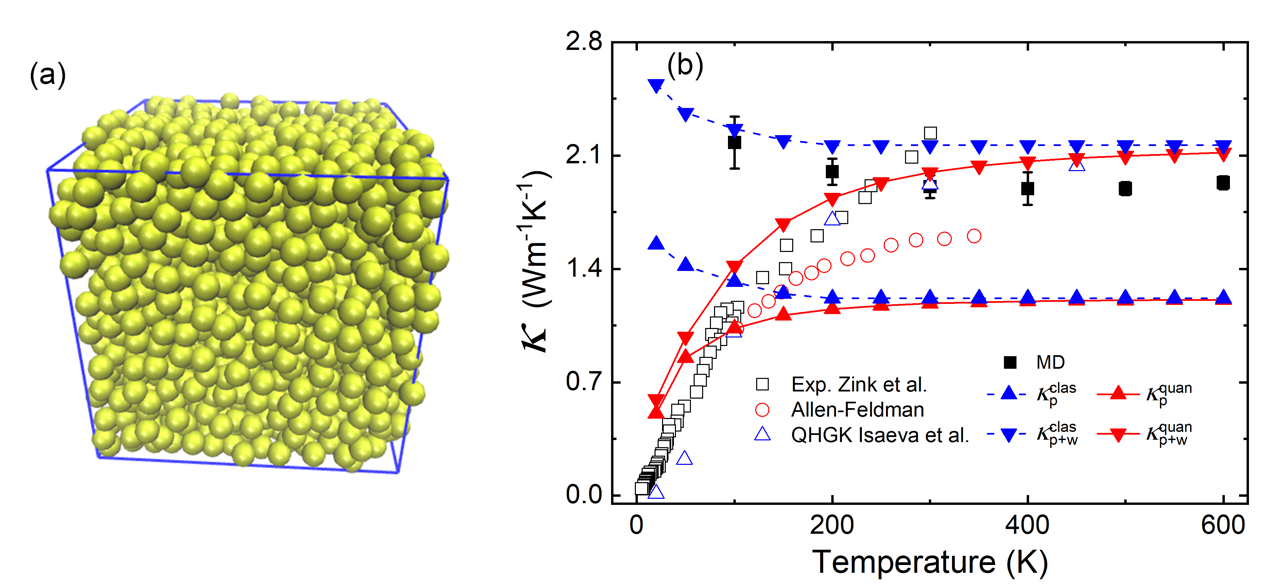On April 29, Professor CHEN Jie's team and their collaborators published a research paper on "how coherence is governing diffusion heat transfer in amorphous solids" online at npj Computational Materials, which marks an important theoretical extension in describing heat transport in amorphous materials.

Figure 1(a) Atomic structure of amorphous silicon; (b) prediction of thermal conductivity of amorphous silicon based on coherent heat transport theory and comparison with other results, in which p (particle-like) is based on particle image and w (wave-like) is based on wave image.
Heat conduction in solid materials performs differently as a result of change in lattice vibration mode, which plays a key role in devices and materials affected by heat management or energy conversion. Different from the relatively mature thermal transport theory based on phonon image in crystalline materials, there are still disputes about thermal vibration and its transport physical image in amorphous materials. Due to the loss of long-range order, i.e. lattice periodicity, as shown in Fig. 1(a), phonon failed to be effective in amorphous materials. Therefore, a phonon gas model based on phonon image is no longer applicable. In the past decades, physicists proposed theories to describe the thermal vibration and transport properties in amorphous materials, among which the AF model developed by Allen and Feldman was influential. Their research showed that the off-diagonal term in the group velocity operator plays an important role in the transport of local non-propagating vibration modes (known as diffuser diffuse-on in amorphous materials), while the off-diagonal term describes the correlation between different modes. Recently, Isaeva et al. proposed a quasi-harmonic Green-Kubo (QHGK) model to explore heat transport in amorphous materials by considering the scattering correlation between different modes. Although both AF model and QHGK model involve the basic correlation between different modes, the deep-seated physical image and mechanism have not been fully understood. In addition, the thermal vibration in the above theoretical model is still regarded as a plane wave equivalent to the phonon image. Its physical image is based on the regular mode and group velocity, and these quantities cannot be clearly defined in the amorphous system, which makes the heat transport mechanism described based on these concepts controversial.
Professor CHEN Jie from the Phonon Center of the School of Physical Science and Engineering, Tongji University and Professor Sebastian Volz from the University of Tokyo revealed the heat transport mechanism in amorphous materials based on their recently developed coherent heat transport theory. They discovered that different from the heat transport dominated by phonon images in crystalline materials, the heat transport in amorphous materials is dominated by both low-frequency propagators and high-frequency diffusers, and the wave coherent image between thermal vibrations plays an important role in the diffusion transport. As shown in Figure 1(b), the thermal conductivity (P+W) of amorphous silicon predicted in this research agrees with the experimental measurement results after the fluctuation characteristics of thermal vibration is taken into consideration. At the same time, the research also provides a clear interpretation of the diffusion transport image for the predicted results of AF model and QHGK model. By taking different thermal vibration modes in amorphous system as collective excited states, the significant transport contribution of wave coherence further reveals the physical mechanism behind the singular dependence of amorphous thermal conductivity on temperature and length caused by diffusions in materials. In addition, due to the wave coherence behavior between them, the propagation length of the collective excited state composed of a large number of diffusers can reach the order of microns, which is significantly larger than the transport length of the low-frequency propagator, and different from the thermal transport properties in crystal materials. The strange wave behavior of diffusers found in this research reveals the image of "vibration mode correlation" which has not been properly interpreted in existing theoretical models of heat transport, and further expounds their contribution to heat transport. The discovery not only introduces a new theoretical framework to understand the mechanism of thermal vibration and heat transport in amorphous materials, but also confirms that the thermal phonon wave coherence has an important impact on the heat transport of a variety of solids, including crystalline and amorphous materials.
The journal npj Computational Materials is one in English on computational physics and computational materials jointly published by Shanghai Institute of Silicate, Chinese Academy of Sciences and British Nature Publishing Group. It was selected as one of "China's most internationally influential academic journal" in 2020. ZHANG Zhongwei, a postdoctoral research fellow from the University of Tokyo in Japan, is the first author of the paper, and Professor CHEN Jie from Tongji and Professor Sebastian Volz from the University of Tokyo are the co-corresponding authors. Professor Volz is the foreign convener of the China-EU Nano Phonon Joint Laboratory of Tongji University and a national high-end foreign expert. He has maintained cooperation with Professor CHEN Jie's research team for a long time. The research was supported by the National Natural Science Foundation of China and the Shanghai Natural Science Foundation.
Link to paper:https://doi.org/10.1038/s41524-022-00776-w